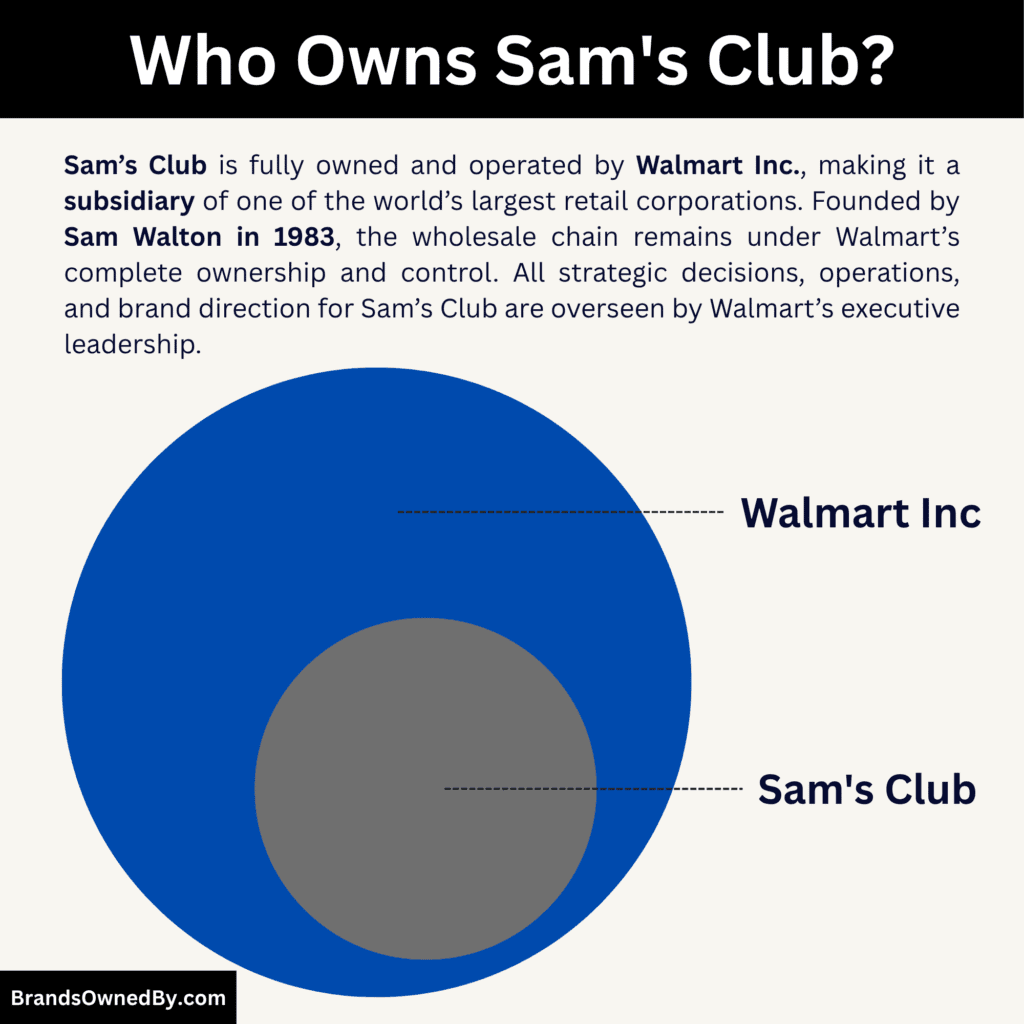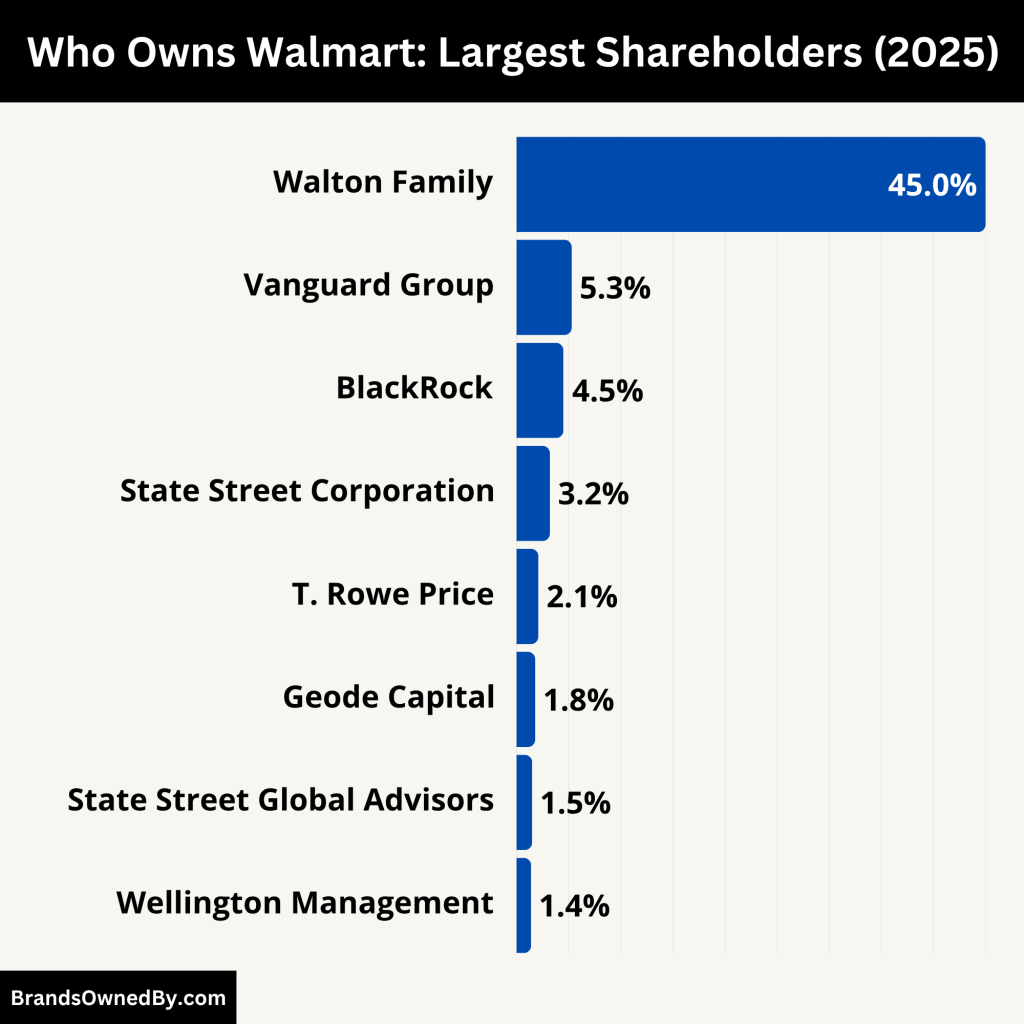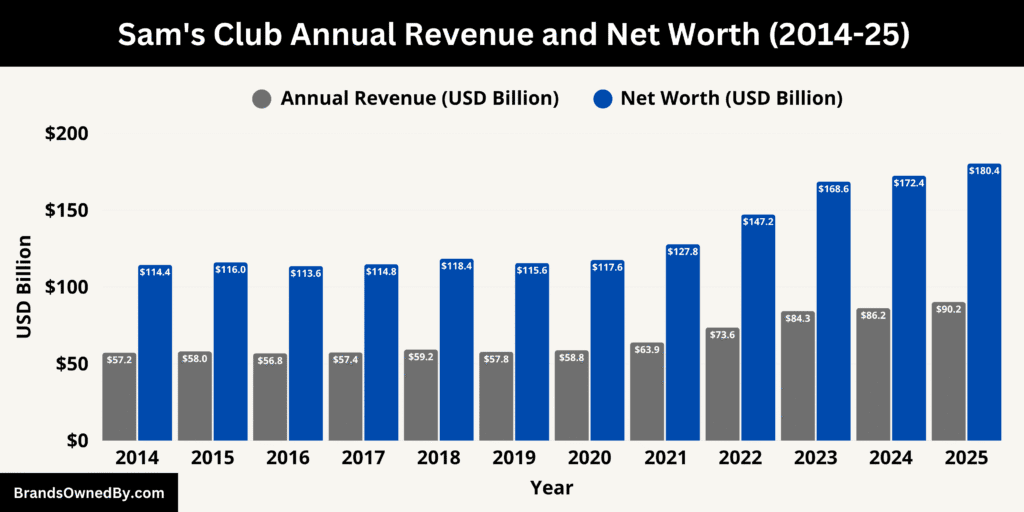Sam’s Club has grown into one of the most recognized membership-only warehouse chains in the United States, attracting millions of loyal shoppers each year. If you’ve ever wondered who owns Sam’s Club stores, the answer lies with retail giant Walmart Inc., the same company behind the world’s largest chain of discount department stores.
Since its founding in 1983 by Sam Walton, Sam’s Club has expanded its footprint nationwide, offering bulk products, exclusive deals, and competitive pricing that have made it a strong competitor in the wholesale retail market.
Sam’s Club Company Profile
Sam’s Club is a membership-based warehouse retailer. It operates hundreds of clubs across the U.S. and internationally. The first club dates back to 1983. In 2025, it remains a key part of Walmart’s portfolio. It serves both individual shoppers and small businesses.
Company Details
Sam’s Club is a division of Walmart Inc. It trades as Sam’s West, Inc. Today, it operates about 600 warehouses in the U.S. across 44 states and Puerto Rico. It also maintains a presence internationally, with nearly 173 locations in Mexico, 48 in China, and 58 in Brazil under license.
Memberships power its business model. Members pay for access to low-cost goods in bulk. The company also offers services like gas stations with car washes, pharmacy, optical, and fuel.
Sam’s Club Founders
Sam’s Club was founded by retail pioneer Sam Walton. He launched the first Sam’s Wholesale Club on April 7, 1983, in Midwest City, Oklahoma. Walton created it as a warehouse club to serve small businesses—and today’s everyday members—with value and convenience.
Major Milestones
Since its founding, Sam’s Club has evolved significantly:
- 1987 – Acquired SuperSaver Wholesale, expanding during its early years.
- 1990 – Dropped “Wholesale” from its name, becoming Sam’s Club.
- 1993 – Acquired Kmart’s PACE Membership Warehouse, converting many locations into Sam’s Club stores.
- Early 2000s – Expanded into Canada briefly.
- 2005 – Responded to Hurricane Katrina with major relief efforts and named Doug McMillon as Sam’s Club CEO.
- 2013 – Sales surpassed $50 billion, with bananas among the top sellers.
- 2016 – Launched Scan & Go mobile checkout feature.
- 2018 – Partnered with Instacart for same-day delivery.
- 2019 – Introduced healthcare pilot programs and named Kath McLay as CEO.
- 2020 – Launched pandemic response services such as Hero Hours and concierge service.
- 2021 – Aired its first Super Bowl commercial featuring Kevin Hart.
- 2022 – Rolled out digital innovations, hot dog price drop promotions, and brand relaunches like Member’s Mark.
- 2023 – Celebrated its 40th anniversary with a New York Stock Exchange bell ringing, $84 billion in sales, and nearly 600 U.S. locations. CEO Chris Nicholas took the helm.
- 2025 – Reported approximately $90.2 billion in annual sales, ranking second among warehouse clubs.
Who Owns Sam’s Club?

Sam’s Club is wholly owned by Walmart Inc. This means Walmart has 100% equity control over the brand. All assets, liabilities, profits, and strategic decisions for Sam’s Club fall under Walmart’s corporate umbrella. Sam’s Club is not traded as a separate public entity, and its financial results are consolidated into Walmart’s overall reports.
Walmart uses Sam’s Club as a dedicated warehouse retail division to target a specific customer base—both individual members and small to mid-sized businesses looking for bulk purchases and competitive prices.
Parent Company – Walmart Inc.

Walmart Inc. is a multinational retail giant headquartered in Bentonville, Arkansas. Founded in 1962 by Sam Walton, Walmart operates thousands of retail outlets worldwide in different formats, including discount stores, supercenters, and warehouse clubs.
Walmart has consistently ranked among the world’s largest companies by revenue. In fiscal year 2025, it generated more than $610 billion in sales. Sam’s Club alone contributed over $90 billion to this total, making it one of Walmart’s most profitable divisions on a per-location basis.
Creation and Development by Walmart
Sam’s Club was created by Walmart in 1983. The first location opened in Midwest City, Oklahoma, under the name “Sam’s Wholesale Club.”
The brand was named after Walmart’s founder, Sam Walton, to reinforce the company’s identity and trust. The goal was to compete with emerging warehouse club retailers by offering lower prices, exclusive memberships, and bulk purchasing options.
While Sam’s Club was built in-house, Walmart has expanded it through targeted acquisitions.
- 1987 – Walmart acquired SuperSaver Wholesale Club, adding to its early store base.
- 1993 – Walmart purchased the PACE Membership Warehouse chain from Kmart, converting many locations to Sam’s Club.
These moves allowed Sam’s Club to rapidly increase its geographic presence without starting from scratch in new markets.
Role of the Walton Family
The Walton family is the largest and most influential shareholder group in Walmart Inc. They collectively control about half of the company’s stock through Walton Enterprises LLC and the Walton Family Holdings Trust.
This high ownership percentage gives the family significant voting power on Walmart’s board of directors. In practice, it means strategic decisions affecting Sam’s Club—such as expansion plans, technology adoption, and competitive positioning—are influenced by the Walton family’s long-term vision.
Institutional Shareholders’ Impact
In addition to the Walton family, major institutional investors hold substantial stakes in Walmart. These include:
- Vanguard Group – Around 7–8% ownership
- BlackRock – Around 5–6% ownership
- State Street Corporation – Around 4–5% ownership.
Although these firms don’t have controlling stakes, they do have the ability to influence corporate governance through shareholder resolutions and votes.
Strategic Significance Inside Walmart
Sam’s Club plays a strategic role as Walmart’s innovation test lab. Many advanced retail technologies are piloted here before being rolled out to Walmart stores, including:
- AI-powered inventory tracking
- Scan & Go mobile checkout
- Cashier-less “Just Walk Out” exits
- Advanced digital membership integration.
Sam’s Club also strengthens Walmart’s e-commerce operations. Its warehouse model is well-suited for online bulk orders and same-day delivery, helping Walmart compete more aggressively with Amazon and Costco.
International Licensing and Operations
While most Sam’s Club stores are in the United States, Walmart operates Sam’s Club internationally through a mix of wholly owned and licensed arrangements. In 2025, Sam’s Club has:
- Nearly 173 clubs in Mexico (via Walmart de México y Centroamérica)
- 48 in China
- 58 in Brazil.
This global presence strengthens Walmart’s brand recognition and diversifies its revenue sources.
Who is the CEO of Sam’s Club?
As of 2025, the President and Chief Executive Officer of Sam’s Club is Chris Nicholas. He assumed the role in September 2023, succeeding Kathryn McLay—who transitioned to lead Walmart International.
Nicholas brings deep operational experience from his tenure as Executive Vice President and COO of Walmart U.S., where he oversaw store operations, supply chain, automation, fulfillment, and strategy.
Chris Nicholas leads Sam’s Club’s strategic transformation. His vision is to position the company as “the world’s best club retailer,” driven by expansive growth, bold innovation, and exceptional member experience.
Chris Nicholas emphasizes building an inclusive, purpose-driven culture—not through formal DEI programs, but through everyday openness and connection. He believes true inclusivity comes from lived values, meaningful interactions, and data-informed decisions.
Key Strategic Initiatives Under Nicholas
- Aggressive Expansion: Plans to open 15 new clubs annually, in addition to 30 previously announced locations.
- Complete Remodel of 600 U.S. Locations: Aligning all clubs with a new high-tech design pioneered at the Grapevine, Texas store.
- AI-Driven Checkout Transformation: Rolling out “Scan & Go” and “Just Go” exit systems nationwide for contactless, frictionless shopping experiences.
- Data-Centric Innovation: Leveraging detailed member profiles and digital feedback to personalize services and accelerate technology adoption.
Organizational Changes and Team
Under Nicholas’s leadership, several new roles and structural shifts have been introduced:
- Diana Marshall elevated to Chief Experience Officer (CXO), overseeing membership, product design, marketing, and advertising to unify member experience.
- Tom Ward appointed Chief Operating Officer (End-to-End), responsible for the omni-channel execution including supply chain and digital operations.
- Julie Barber takes on Chief Merchandising Officer for Sam’s Club, following her previous role at Walmart U.S.
Sam’s Club Annual Revenue and Net Worth
Sam’s Club delivered $90.2 billion in net sales in fiscal 2025, led by strong contributions from grocery and healthy gains in health & wellness. As of August 2025, the estimated net worth of Sam’s Club is around $180.4 billion.

Annual Revenue
In fiscal year 2025, Sam’s Club U.S. reported net sales of $90.2 billion, a clear step up from $86.2 billion in 2024. These sales accounted for approximately 13% of Walmart’s total consolidated revenues.
This solid year-over-year growth reflects gains in both store performance and customer engagement. Comparable-store sales—those from locations open for at least a year—rose by nearly 6%, underscoring consistent demand across the chain.
Quarterly performance also contributed toward this annual total. In the fourth quarter of FY 2025, Sam’s Club generated sales of $23.1 billion, which marked a 5.7% increase compared to the same quarter in the previous year.
Over the third quarter, net sales reached $22.9 billion, representing a 3.9% rise versus the same period in FY 2024.
Sam’s Club’s revenue spans multiple product categories, with grocery and fuel among the top contributors. Grocery remains the largest category, bringing in around $60 billion in FY 2025.
Fuel and related sales added approximately $12.9 billion, while general merchandise accounted for $11.2 billion, and health and wellness contributed $6.1 billion.
These figures highlight shifting priorities as health and wellness products enjoyed a strong increase after previously seeing slower growth.
Sam’s Club Net Worth
Sam’s Club does not report its own standalone net worth; it is fully incorporated into Walmart Inc.’s financials. Still, the consistent, healthy growth in net sales—reaching $90.2 billion in 2025—signals its critical role as a high-value asset within Walmart’s diversified retail portfolio.
The estimated net worth of Sam’s Club as of August 2025 is around $180.4 billion based on its revenue and analysis.
Sam’s Club has demonstrated strong momentum during FY 2025, backed by double-digit growth in membership income and e-commerce transactions. An increasing share of members now shop via digital tools such as Scan & Go, fueling a 27% rise in e-commerce sales in early FY 2026.
Here’s an overview of the historical revenue and net worth of Sam’s Club:
| Fiscal Year | Annual Revenue (USD Billion) | Estimated Net Worth (USD Billion, approx.) |
|---|---|---|
| 2014 | 57.2 | 114.4 |
| 2015 | 58.0 | 116.0 |
| 2016 | 56.8 | 113.6 |
| 2017 | 57.4 | 114.8 |
| 2018 | 59.2 | 118.4 |
| 2019 | 57.8 | 115.6 |
| 2020 | 58.8 | 117.6 |
| 2021 | 63.9 | 127.8 |
| 2022 | 73.6 | 147.2 |
| 2023 | 84.3 | 168.6 |
| 2024 | 86.2 | 172.4 |
| 2025 | 90.2 | 180.4 |
Brands Owned by Sam’s Club
In 2025, Sam’s Club directly owns and operates several internal brands—Member’s Mark, Simply Right, Bakers & Chefs, Daily Chef—and relies on a manufacturing entity like Richelieu Foods for private-label production support. These brands and entities emphasize Sam’s Club’s commitment to quality, value, innovation, and meeting diverse member needs through exclusive and purpose-driven offerings.
Here’s a list of the major divisions and brands owned by Sam’s Club as of 2025:
Member’s Mark
Member’s Mark is Sam’s Club’s flagship private-label brand. It spans a wide range of categories, from groceries to household goods, providing high-quality products at competitive prices. This brand has evolved through a focused overhaul that streamlined multiple sub-brands into one and invested heavily in innovation, quality, and sustainability.
In 2025, Member’s Mark continues to lead with purpose-driven initiatives—96% of its food and beverage items now meet “Made Without” standards, emphasizing cleaner, more recognizable ingredients. The brand also extends into fresh offerings, such as in-club sushi crafted daily by trained chefs, often under regional-specific names that cater to modern, health-conscious members.
Simply Right
Simply Right serves as an accessible private-label offering primarily in value-focused grocery and everyday household essentials. It complements Sam’s Club’s overall value portfolio, ensuring members can find affordable alternatives to name brands without compromising on quality.
Bakers & Chefs
Bakers & Chefs is Sam’s Club’s specialty brand tailored for culinary and baking enthusiasts, as well as small food businesses. The line includes premium baking ingredients, chef-grade supplies, and gourmet items designed to meet professional standards, reflecting Sam’s Club’s commitment to serving both individual consumers and small enterprises.
Daily Chef
The Daily Chef brand caters to the convenience-oriented segment of Sam’s Club shoppers. It includes ready-to-eat or easy-to-heat meals and comfort food selections made for quick preparation and everyday enjoyment, offering time-saving solutions without sacrificing taste.
Richelieu Foods (private label manufacturing)
Richelieu Foods is a manufacturing partner that produces certain private-label selections for Sam’s Club. Though not a brand visible to consumers, this entity plays a strategic role in ensuring Sam’s Club can offer a broad spectrum of private-label products by leveraging external production capabilities aligned with quality and efficiency goals.
Final Thoughts
Sam’s Club remains one of the leading membership-only warehouse clubs in the United States, with a strong market presence and loyal customer base. Its ownership under Walmart Inc. provides it with significant financial strength, operational expertise, and access to vast supply chain resources.
It has expanded its reach through physical locations and digital platforms, catering to both individual and business members. With a focus on value, bulk purchasing, and exclusive member benefits, Sam’s Club continues to grow and adapt to changing retail trends.
As of 2025, the story of who owns Sam’s Club reflects a strategic partnership between a powerful parent company and a brand committed to delivering consistent savings and quality to its members.
FAQs
Who owns Sam’s Club stores?
Sam’s Club stores are owned by Walmart Inc., the largest retailer in the world. Walmart operates Sam’s Club as one of its major subsidiaries.
When was Sam’s Club founded?
Sam’s Club was founded in 1983 in Midwest City, Oklahoma, by Walmart founder Sam Walton.
Is Sam’s Club owned by Walmart?
Yes. Sam’s Club has been owned by Walmart since its creation and is operated as a wholly owned division of the company.
When was Sam’s Club established?
Sam’s Club was officially established in April 1983.
Who owns Sam’s Club and Walmart?
Both Sam’s Club and Walmart are publicly traded under Walmart Inc., which is controlled by the Walton family through Walton Enterprises LLC and Walton Family Holdings Trust.
Does Costco own Sam’s Club?
No. Costco and Sam’s Club are separate companies and direct competitors in the warehouse club industry. Costco is not affiliated with Sam’s Club.
Who is the original owner of Sam’s Club?
The original owner and founder of Sam’s Club is Sam Walton, who also founded Walmart.
Which country owns Sam’s Club?
Sam’s Club is owned by Walmart Inc., a United States-based corporation headquartered in Bentonville, Arkansas.
When did Walmart buy Sam’s Club?
Walmart did not buy Sam’s Club from another company. It created and launched Sam’s Club in 1983 as part of its retail expansion.
Who controls decisions at Sam’s Club?
Decisions at Sam’s Club are made by its executive leadership team, headed by the President and CEO of Sam’s Club. Strategic decisions are also influenced by Walmart’s corporate leadership and board of directors.

